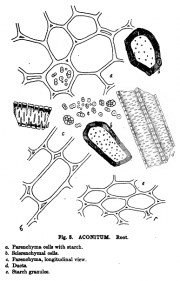|
|
| Line 1: |
Line 1: |
| − | {{Botanical | source=Schneider, A. (1921) The Microanalysis of Powdered Vegetable Drugs, 2nd ed. | + | {{Microscopy | source=Schneider, A. (1921) The Microanalysis of Powdered Vegetable Drugs, 2nd ed. |
| | | mainimage=Microanalysis_powdered_vegetable_p_208_google_ver_aconitum_root.PNG | | | mainimage=Microanalysis_powdered_vegetable_p_208_google_ver_aconitum_root.PNG |
| | | description=Wolf's Bane (root) (''Aconitum napellus''). | | | description=Wolf's Bane (root) (''Aconitum napellus''). |
Revision as of 19:18, 30 December 2011
| Wolf's Bane (root) (Aconitum napellus).Predominating elements are derived from the more or less broken, large, rather thick-walled, essentially isodiametric closely united parenchyma cells filled with compound starch granules. A few slightly brownish, essentially rectangular only slightly elongated, rather thin-walled, very porous sclerenchyma cells, which generally occur singly, rarely in twos. Some porus ducts and tracheids; spiral ducts rare.
Starch granules singly, in twos, fours, and aggregates of from five to seven; hili distinct in the larger granules, centric; single granules 5μ to 15μ; cross bands quite distinct, broad, right angled. There should be no thick-walled sclerenchyma, no true bast, and vascular tissue should be sparingly present.
Source: Schneider, A. (1921) The Microanalysis of Powdered Vegetable Drugs, 2nd ed. [1]
|
|
|
|
Cite error: <ref> tags exist, but no <references/> tag was found
